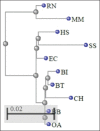Comparative modeling and mutual docking of structurally uncharacterized heat shock protein 70 and heat shock factor-1 proteins in water buffalo
- PMID: 32095057
- PMCID: PMC6989329
- DOI: 10.14202/vetworld.2019.2036-2045
Comparative modeling and mutual docking of structurally uncharacterized heat shock protein 70 and heat shock factor-1 proteins in water buffalo
Abstract
Aim: In this study, a wide range of in silico investigation of Bubalus bubalis (BB) heat shock protein 70 (HSP70) and heat shock factor-1 (HSF1) has been performed, ranging from sequence evaluation among species to homology modeling along with their docking studies to decipher the interacting residues of both molecules.
Materials and methods: Protein sequences of BB HSP70 and HSF1 were retrieved from NCBI database in FASTA format. Primary and secondary structure prediction were computed using Expasy ProtParam server and Phyre2 server, respectively. TMHMM server was used to identify the transmembrane regions in HSP70. Multiple sequence alignment and comparative analysis of the protein was carried out using MAFFT and visualization was created using ESPript 3.0. Phylogenetic analysis was accomplished by COBALT. Interactions of HSP70 with other proteins were studied using STRING database. Modeller 9.18, RaptorX, Swiss-Modeller, Phyre2, and I-TASSER were utilized to design the three-dimensional structure of these proteins followed by refinement; energy minimization was accomplished using ModRefiner and SPDBV program. Stereochemical quality along with the accuracy of the predicted models and their visualization was observed by PROCHECK program of PDBsum and UCSF Chimera, respectively. ClusPro 2.0 server was accessed for the docking of the receptor protein with the ligand.
Results: The lower value of Grand Average of Hydropathy indicates the more hydrophilic nature of HSP70 protein. Value of the instability index (II) classified the protein as stable. No transmembrane region was reported for HSP70 by TMHMM server. Phylogenetic analysis based on multiple sequence alignments (MSAs) by COBALT indicated more evolutionarily closeness of Bos indicus (BI) with Bos taurus as compared to BI and BB. STRING database clearly indicates the HSF1 as one of the interacting molecules among 10 interacting partners with HSP 70. The best hit of 3D model of HSP70 protein and HSF1 was retrieved from I-TASSER and Phyre2, respectively. Interacting residues and type of bonding between both the molecules which were docked by ClusPro 2.0 were decoded by PIC server. Hydrophobic interactions, protein-protein main-chain-side-chain hydrogen bonds, and protein-protein side-chain-side-chain hydrogen bonds were delineated in this study.
Conclusion: This is the first-ever study on in silico interaction of HSP70 and HSF1 proteins in BB. Several bioinformatics web tools were utilized to study secondary structure along with comparative modeling, physicochemical properties, and protein-protein interaction. The various interacting amino acid residues of both proteins have been indicated in this study.
Keywords: Bubalus bubalis; docking; heat shock factor-1; heat shock protein 70; heat shock proteins; homology modeling.
Copyright: © Singh, et al.
Figures











Similar articles
-
Novel polymorphisms in UTR and coding region of inducible heat shock protein 70.1 gene in tropically adapted Indian zebu cattle (Bos indicus) and riverine buffalo (Bubalus bubalis).Gene. 2013 Sep 25;527(2):606-15. doi: 10.1016/j.gene.2013.05.078. Epub 2013 Jun 19. Gene. 2013. PMID: 23792016
-
Computational genome-wide identification of heat shock protein genes in the bovine genome.F1000Res. 2018 Sep 20;7:1504. doi: 10.12688/f1000research.16058.1. eCollection 2018. F1000Res. 2018. PMID: 30542619 Free PMC article.
-
Expression profiling of major heat shock protein genes during different seasons in cattle (Bos indicus) and buffalo (Bubalus bubalis) under tropical climatic condition.J Therm Biol. 2015 Jul;51:55-64. doi: 10.1016/j.jtherbio.2015.03.006. Epub 2015 Mar 17. J Therm Biol. 2015. PMID: 25965018
-
In silico analysis and homology modeling of strictosidine synthase involved in alkaloid biosynthesis in catharanthus roseus.J Genet Eng Biotechnol. 2020 Aug 28;18(1):44. doi: 10.1186/s43141-020-00049-3. J Genet Eng Biotechnol. 2020. PMID: 32857261 Free PMC article.
-
PDBparam: Online Resource for Computing Structural Parameters of Proteins.Bioinform Biol Insights. 2016 Jun 14;10:73-80. doi: 10.4137/BBI.S38423. eCollection 2016. Bioinform Biol Insights. 2016. PMID: 27330281 Free PMC article. Review.
Cited by
-
Study on cocoonase, sericin, and degumming of silk cocoon: computational and experimental.J Genet Eng Biotechnol. 2021 Feb 16;19(1):32. doi: 10.1186/s43141-021-00125-2. J Genet Eng Biotechnol. 2021. PMID: 33594479 Free PMC article.
-
Unleashing the Potential of EIL Transcription Factors in Enhancing Sweet Orange Resistance to Bacterial Pathologies: Genome-Wide Identification and Expression Profiling.Int J Mol Sci. 2023 Aug 10;24(16):12644. doi: 10.3390/ijms241612644. Int J Mol Sci. 2023. PMID: 37628825 Free PMC article.
-
The TolC and Lipopolysaccharide-Specific Escherichia coli Bacteriophage TLS-the Tlsvirus Archetype Virus.Phage (New Rochelle). 2024 Sep 16;5(3):173-183. doi: 10.1089/phage.2023.0041. eCollection 2024 Sep. Phage (New Rochelle). 2024. PMID: 39372356 Free PMC article.
-
The Fe-S cluster biosynthesis in Enterococcus faecium is essential for anaerobic growth and gastrointestinal colonization.Gut Microbes. 2024 Jan-Dec;16(1):2359665. doi: 10.1080/19490976.2024.2359665. Epub 2024 Jun 3. Gut Microbes. 2024. PMID: 38831611 Free PMC article.
-
In Silico Design of a Chimeric Humanized L-asparaginase.Int J Mol Sci. 2023 Apr 20;24(8):7550. doi: 10.3390/ijms24087550. Int J Mol Sci. 2023. PMID: 37108713 Free PMC article.
References
-
- Creagh E.M, Carmody R.J, Cotter T.G. Heat shock protein 70 inhibits caspase-dependent and-independent apoptosis in Jurkat T cells. Exp. Cell. Res. 2000;257(1):58–66. - PubMed
-
- Lindquist S, Craig E.A. The heat-shock proteins. Annu. Rev. Genet. 1988;22(1):631–677. - PubMed
-
- Archana P.R, Aleena J, Pragna P, Vidya M.K, Niyas A.P.A, Bagath M, Krishnan G, Manimaran A, Beena V, Kurien E.K, Sejian V. Role of heat shock proteins in livestock adaptation to heat stress. J. Dairy Vet. Anim. Res. 2017;5(1):00127.
-
- Pawar H.N, Kumar G.R, Narang R, Agrawal R.K. Heat and cold stress enhances the expression of heat shock protein 70, heat shock transcription factor 1 and cytokines (IL-12, TNF-and GMCSF) in buffaloes. Int. J. Curr. Microbiol. Appl. Sci. 2014;3(2):307–317.
LinkOut - more resources
Full Text Sources
